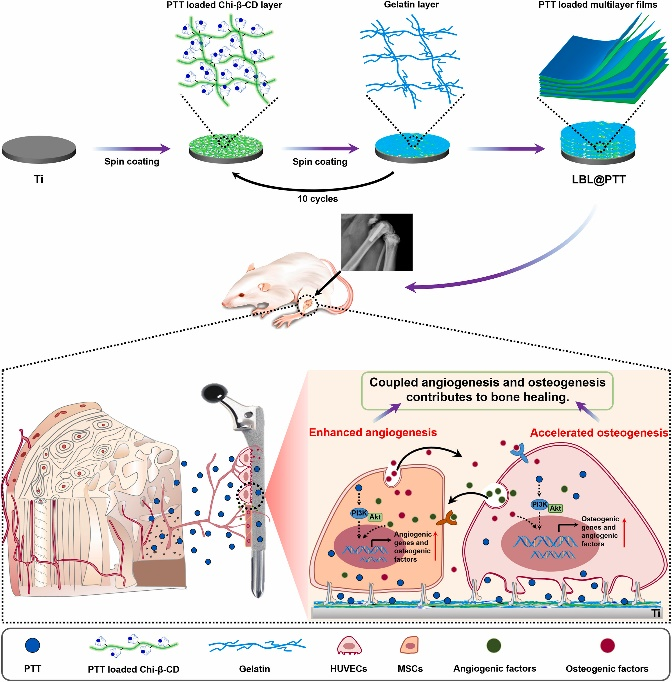The guided endogenous mesenchymal stem cells recruitment and angiogenesis through bone implants surface modification are the most essential for proper bone regeneration and enhanced osseointegration. However, most reported studies were conducted to endow implant surface with multiple functionalities via multiple bio-active compounds and complicated strategies. Moreover, our understanding of the regulatory mechanism of surface coatings for vascularization and osteogenesis liaison is incomplete, especially regarding the involved underlying cellular and molecular mechanisms.
To address these issues, Recently, the research group led by Dr. CHEN Weizhen from The First Affiliated Hospital, Zhejiang University School of Medicine, constructed a pitavastatin loaded multilayered films structure on metal implants substrates with osteogenic and angiogenic properties, and investigated the potential underlying cellular and molecular mechanisms involved as well. Their research findings were published in Biomaterials (IF=12.479), entitled "An improved osseointegration of metal implants by pitavastatin loaded multilayer films with osteogenic and angiogenic properties".

Figure. 1. A simplified illustration of fabricating PTT loaded multilayer films on pure Ti surfaces and schematic summary for the mechanism of the films regulating osteogenesis and angiogenesis.
In the present work, the researchers constructed a pitavastatin loaded multilayered films structure on titanium substrates by the layer-by-layer assembly of pitavastatin-loaded β-cyclodextrin grafted chitosan (Chi-β-CD@PTT) and gelatin (Gel). The researchers systematically investigated the osteogenic and angiogenic properties of the films in vitro and in vivo, as well as the underlying cellular and molecular mechanisms. In vitro experiments demonstrated that locally applied pitavastatin could dramatically enhance osteogenic potential of mesenchymal stem cells (MSCs) and angiogenic potential of endothelial cells. Moreover, pitavastatin loaded multilayer films could also regulate the paracrine signaling mediated crosstalk between endothelial and osteoblastic cells, and indirectly increase the angiogenic potential of MSCs and osteogenic potential of endothelial cells via multiple paracrine signaling. The results of subcutaneous and femur implantation confirmed that locally released pitavastatin could potentially accelerate a sequence of biological events: mobilizing endogenous stem cells and endothelial cells to the implant-bone interface, which in turn facilitating coupled osteogenesis and angiogenesis, and eventually enhancing peri-implant osseointegration.
"Our study provides a fairly feasible approach for developing a multifunctional bioactive coating on the surfaces of mental implants for orthopedic applications. This study also enlarges the application scope of pitavastatin in bone healing field." summarized by Dr. CHEN.
More information:
Dr. CHEN Weizhen, from FAHZU Laboratory Medicine Department, is the lead-contact and first author. Dr XU Kui from The Second Clinical Medical College of Jinan University is also the co-corresponding author. This work was financially supported by the National Natural Science Foundation of China (Nos. 81802133 and 82002272).


